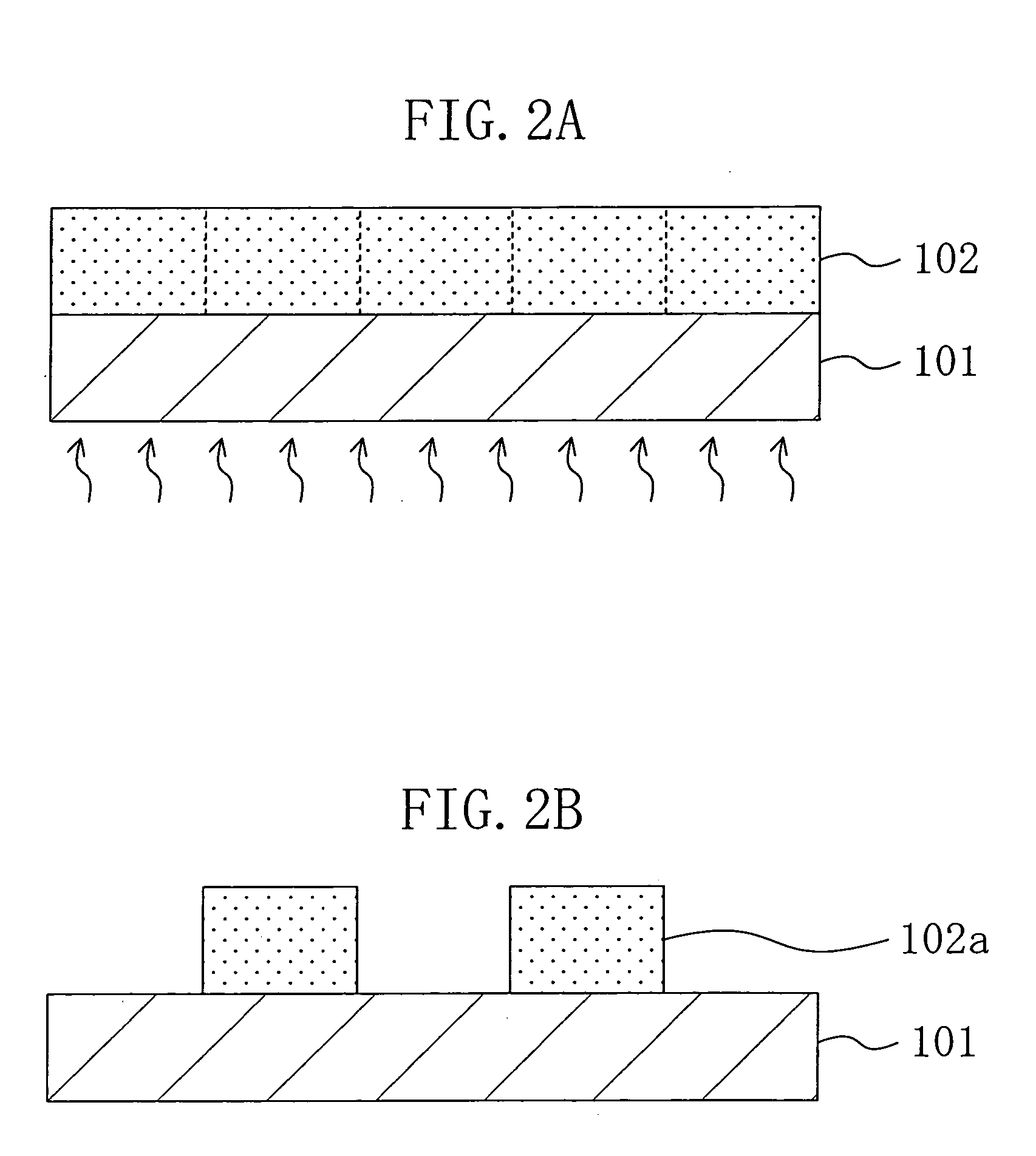Pattern formation method
a technology of pattern formation and formation liquid, which is applied in the direction of photomechanical equipment, instruments, photosensitive material processing, etc., can solve the problems of difficult uniform diffusion of immersion liquid, affecting the production efficiency and reducing the productivity and yield of semiconductor devices. achieve good shape, improve the adhesion to the resist film of immersion liquid, and prevent abnormal exposure
- Summary
- Abstract
- Description
- Claims
- Application Information
AI Technical Summary
Benefits of technology
Problems solved by technology
Method used
Image
Examples
embodiment 1
[0043] A pattern formation method according to Embodiment 1 of the invention will now be described with reference to FIGS. 1A through 1C, 2A and 2B.
[0044] First, a positive chemically amplified resist material having the following composition is prepared:
Base polymer: poly((norbornene-5-methylene-t- 2 gbutylcarboxylate) (50 mol %) - (maleic anhydride) (50 mol %))Acid generator: triphenylsulfonium triflate0.06 gSolvent: propylene glycol monomethyl ether acetate 20 g
[0045] Next, as shown in FIG. 1A, the aforementioned chemically amplified resist material is applied on a substrate 101 so as to form a resist film 102 with a thickness of 0.35 μm.
[0046] Then, as shown in FIG. 1B, a surface reforming treatment for improving the hydrophilic property of the surface of the resist film 102 is performed by exposing the surface of the resist film 102 to an aqueous solution 103 of acetic acid with a concentration of approximately 3×10−3 wt % for 15 seconds by, for example, a puddle method. ...
embodiment 2
[0053] A pattern formation method according to Embodiment 2 of the invention will now be described with reference to FIGS. 4A through 4C, 5A and 5B.
[0054] First, a positive chemically amplified resist material having the following composition is prepared:
Base polymer: poly((norbornene-5-methylene-t- 2 gbutylcarboxylate) (50 mol %) - (maleic anhydride) (50 mol %))Acid generator: triphenylsulfonium triflate0.06 gSolvent: propylene glycol monomethyl ether acetate 20 g
[0055] Next, as shown in FIG. 4A, the aforementioned chemically amplified resist material is applied on a substrate 201 so as to form a resist film 202 with a thickness of 0.35 μm.
[0056] Then, as shown in FIG. 4B, the surface reforming treatment for improving the hydrophilic property of the surface of the resist film 202 is performed by exposing the surface of the resist film 202 to an aqueous solution 203 of benzylmethylammonium chloride, that is, a surface active agent, with a concentration of approximately 7×10−3 ...
embodiment 3
[0063] A pattern formation method according to Embodiment 3 of the invention will now be described with reference to FIGS. 6A through 6C, 7A and 7B.
[0064] First, a positive chemically amplified resist material having the following composition is prepared:
Base polymer: poly((norbornene-5-methylene-t- 2 gbutylcarboxylate) (50 mol %) - (maleic anhydride) (50 mol %))Acid generator: triphenylsulfonium triflate0.06 gSolvent: propylene glycol monomethyl ether acetate 20 g
[0065] Next, as shown in FIG. 6A, the aforementioned chemically amplified resist material is applied on a substrate 301 so as to form a resist film 302 with a thickness of 0.35 μm.
[0066] Then, as shown in FIG. 6B, the surface reforming treatment for improving the hydrophilic property of the surface of the resist film 302 is performed by exposing the surface of the resist film 302 to an aqueous solution 303 of α-cyclodextrin with a concentration of approximately 5×10−3 wt % for 25 seconds by, for example, the puddle m...
PUM
| Property | Measurement | Unit |
|---|---|---|
| thickness | aaaaa | aaaaa |
| temperature | aaaaa | aaaaa |
| width | aaaaa | aaaaa |
Abstract
Description
Claims
Application Information
 Login to View More
Login to View More - R&D
- Intellectual Property
- Life Sciences
- Materials
- Tech Scout
- Unparalleled Data Quality
- Higher Quality Content
- 60% Fewer Hallucinations
Browse by: Latest US Patents, China's latest patents, Technical Efficacy Thesaurus, Application Domain, Technology Topic, Popular Technical Reports.
© 2025 PatSnap. All rights reserved.Legal|Privacy policy|Modern Slavery Act Transparency Statement|Sitemap|About US| Contact US: help@patsnap.com



